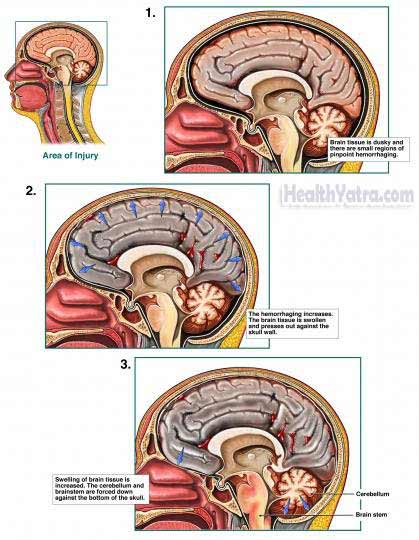Definition
Anoxic brain damage is injury to the brain due to a lack of oxygen. Brain cells without oxygen will begin to die after about four minutes.

Causes
Oxygen is carried to the brain in the blood. Anoxic brain damage may occur if:
- Blood flow to the brain is blocked or slowed. This can happen with:
- Blood clot or stroke—blood flow to an area of the brain is blocked
- Shock and heart problems, like heart attack—blood is not pumped effectively enough to reach the brain
- The blood flow is normal but the blood is not carrying enough oxygen. This may happen because of medical conditions like:
- Lung disease—oxygen has trouble passing from the lungs to the blood
- Chronic anemia—a condition that results in low red blood cells, these cells carry the oxygen in blood
- You have exposure to certain poisons or other toxins. For example, carbon monoxide poisoning keeps your blood from picking up oxygen.
- There is a lack of oxygen in the air. This can occur at high altitudes.
Risk Factors
The following accidents and health problems increase your risk of anoxic brain damage:
- Cardiac arrest
- Choking
- Suffocation
- Near-drowning
- Electrical shock
- Malfunctioning gas appliances that produce carbon monoxide
- Heart attack
- Heart arrhythmia (abnormal heart beats)
- Stroke
- Brain tumors
- Drug use
Symptoms
Severe damage may lead to a coma or a vegetative state. Mild to moderate anoxic brain damage may cause:
- Headache
- Confusion
- Decreased concentration and attention span
- Mood swings and/or personality change
- Intermittent loss of consciousness
- Seizures
- Parkinson’s like syndrome
- Abnormal muscle jerks with movements
Rarely there may be a decline in brain function a few days or weeks after the event occurred. This is caused by delayed injury in the brain. Symptoms may then improve gradually over time.
Diagnosis
The doctor will ask about your symptoms and medical history. A physical exam will be done. You may need to see a doctor who specializes in brain problems.
These tests may be ordered to learn the extent of the brain damage and the part of the brain that is involved:
- Head CT scan —a type of x-ray that uses a computer to make detailed images of the brain
- MRI scan —a test that uses magnetic waves to make pictures of structures inside the head
- Electroencephalogram (EEG) —a test that measures the electrical activity generated by the brain
- SPECT scans—a type of CT scan that examines areas of the brain for blood flow and metabolism.
- Evoked potential tests—tests used to evaluate the visual, auditory, and sensory pathways
Treatment
Initial Treatment
Treatment of anoxic brain damage will depend on the cause. Some treatment options include:
- Medication to:
- Slow down brain activity and decrease need for oxygen
- Reduce the swelling from injured brain tissue—swelling can cause further damage
- Oxygen therapy—to increase the amount of oxygen in the blood
- Efforts to cool the brain—to help limit brain damage.
- Hyperbaric oxygen treatment —may be used with carbon monoxide poisoning
Rehabilitation
Recovery from brain damage can be uncertain. It will also take time. Your chance for recovery depends on how long and how severely you were deprived of oxygen. Many people with mild brain damage can usually recover most of the lost functions.
During rehabilitation, you and your family will work with:
- Physical therapist—to retrain motor skills, such as walking
- Occupational therapist—to improve daily skills, such as dressing and going to the bathroom
- Speech therapist—to work on language problems
- Neuropsychologist—for behavior and emotional issues related to the injury
Recovery can take months, or even years. In many cases, full recovery is never achieved but some can successfully learn to live with any remaining disabilities. In general, the sooner rehabilitation starts, the better the outcome.
Medication
Your doctor may have you take the following medicines:
- Anti-epileptic medicines—to treat ongoing seizures
- Clonazepam (eg, Klonopin)—to treat muscle jerks
Prevention
To reduce the risk of anoxic brain damage:
- Chew your food carefully.
- Learn to swim.
- Carefully supervise young children around water.
- Stay clear of high voltage electrical sources (including exposure to lightning).
- Avoid chemical toxins and illicit drugs.
- Check gas burning appliances for carbon monoxide production and install carbon monoxide detectors.
Anoxic Brain Damage Treatment in India – Page Keywords:
Anoxic Brain Damage Definition, Anoxic Brain Damage Definition Causes, Anoxic Brain Damage Symptoms, Anoxic Brain Damage Treatment in India, Anoxic Brain Damage Treatment Cost in India, Anoxic Brain Damage Surgery Cost, Top Anoxic Brain Damage Treatment Hospital, Top Anoxic Brain Damage Treatment Doctor in India, Anoxic Brain Damage Meaning in Marathi, Anoxic Brain Damage Treatment Near me, Anoxic Brain Damage Complications, Travel India for Anoxic Brain Damage Treatment, Anoxic Brain Damage Treatment in Arab Countries, Anoxic Brain Damage Treatment in Bangladesh, Anoxic Brain Damage Treatment in Dhaka, Anoxic Brain Damage Meaning in Bengali, Anoxic Brain Damage Meaning in Arabic, Anoxic Brain Damage Meaning in Hindi, Anoxic Brain Damage Treatment in Bahrain, Anoxic Brain Damage Treatment in Egypt, Anoxic Brain Damage Treatment in Iraq, Anoxic Brain Damage Treatment in Jordan, Anoxic Brain Damage Treatment in Kuwait, Anoxic Brain Damage Treatment in Lebanon, Anoxic Brain Damage Treatment in Saudi Arabia, Anoxic Brain Damage Treatment in United Arab Emirates, Anoxic Brain Damage Treatment in Sudan, Anoxic Brain Damage Treatment in Tunisia, Anoxic Brain Damage Treatment in Nepal, Anoxic Brain Damage Treatment cost,
